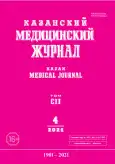Clinical and economic analysis of dental caries prevention using fluorine-containing sealants
- Authors: Shaymieva NI1, Khasanov RS.1, Olesova VN2
-
Affiliations:
- Kazan State Medical Academy — Branch of the Russian Medical Academy of Continuing Professional Education
- A.I. Burnasyan Federal Medical Biophysical Center
- Issue: Vol 102, No 4 (2021)
- Pages: 545-550
- Section: Social hygiene and healthcare management
- URL: https://bakhtiniada.ru/kazanmedj/article/view/70740
- DOI: https://doi.org/10.17816/KMJ2021-545
- ID: 70740
Cite item
Abstract
Aim. To conduct a clinical and economic analysis of the effectiveness of the program fissure sealing of first permanent molars with fluorine-containing sealants among schoolchildren of 7–8 years old in six cities of the Republic of Tatarstan.
Methods. Between 2007 and 2011, dentists of six cities of the Republic of Tatarstan performed fissure sealing of permanent first molars using a fluorine-containing sealant in 24,394 schoolchildren aged 7–8 years according to the manufacturer's instruction. A clinical assessment of fluorine-containing sealant retention during tooth eruption was carried out annually, the results were submitted to the organizational and methodological office of the Republican Dental Clinic. The analysis of the complex of signs that have a normal distribution and characterize four degrees of sealant retention on the occlusal surfaces of teeth in children from several cities was carried out by using one-way ANOVA (analysis of variance) with the calculation of a p-value and F-test (according to Ronald Fischer). Statistical data processing was performed using the Microsoft Office Excel 2017 software. The economic analysis was performed by using mathematical modelling.
Results. The use of sealants at the age of 7–8 years ensured the complete safety of the sealant in 80% of children; the development of dental caries in 1.7%; complete and partial loss — 14.3%; disturbance of fit without the development of caries — in 4.1% of cases [р=0.0095 (<0.01); f-test 3.09839]. Clinical and economic analysis using a mathematical hypothesis in sealing with a fluorine-containing composite sealant determined the preservation of the conditionally spent funds for the treatment of 80% of healthy teeth for 4 years of the project in the amount of 6,001,177 rubles. Notional saved costs for the treatment of one tooth with a sealant amounted to 23.7 rubles.
Conclusion. Implementation of the program fissure sealing of first permanent molars with fluorine-containing sealants among schoolchildren of 7–8 years old allows a total of 98.3% of healthy teeth to be preserved and notionally saved costs of sealing fissures to be reduced.
Full Text
##article.viewOnOriginalSite##About the authors
N I Shaymieva
Kazan State Medical Academy — Branch of the Russian Medical Academy of Continuing Professional Education
Author for correspondence.
Email: nailya.shaymieva@mail.ru
Russian Federation, Kazan, Russia
R Sh Khasanov
Kazan State Medical Academy — Branch of the Russian Medical Academy of Continuing Professional Education
Email: ksma.rf@tatar.ru
Russian Federation, Kazan, Russia
V N Olesova
A.I. Burnasyan Federal Medical Biophysical Center
Email: olesova@fmbcfmba.ru
Russian Federation, Moscow, Russia
References
- Leontyev V.K. On etiology of dental caries. Institut stomatologii. 2019; (1): 34–35. (In Russ.)
- Leous P.A. Evidence-based oral health dental ¬science in prevention of dental caries in children population. Stomatologiya detskogo vozrasta i profilaktika. 2008; 7 (2): 3–11. (In Russ.)
- Kouzmina E.M. Up-to-date approaches to dental caries prevention. Dental Forum. 2011; (2): 2–8. (In Russ.)
- Toumba K.J., Twetman S., Splieth C., Parnell C., van Loveren C., Lygidakis N.A. Guidelines on the use of fluo¬ride for caries prevention in children: an updated EAPD policy document. Eur. Arch. Paediatr. Dent. 2019; 20 (6): 507–516. doi: 10.1007/s40368-019-00464-2.
- Terekhava T.N., Shakavets N.V., Melnikava E.I., Klenovskaya M.I., Naumovich D.N., Cherniauskaya N.D. A differentiated approach to the dental caries prevention in children with different levels of caries risk. Stomatolo¬giya detskogo vozrasta i profilaktika. 2020; 20 (3): 211–215. (In Russ.) doi: 10.33925/1683-3031-2020-20-3-211-215.
- Kiselnikova L.P., Wei L., Shevchenko M.A. Use of sealing methods to regulate the maturation processes of hard tissues in children’s temporary molars. Klinicheskaya stomatologiya. 2019; (4): 4–7. (In Russ.) doi: 10.37988/1811-153X_2019_4_4.
- Kerdya¬shova A.A., Nadeykina O.S., Tiunova I.N. Principles of sealing teeth fissures in children. Innovatsii. Nauka. Obrazovanie. 2021; (29): 359–363. (In Russ.)
- Ahovuo-Saloranta A., Forss H., Walsh T., Hiiri A., Nordblad A., Mäkelä M., Worthington H.V. Sea¬lants for preventing dental decay in the permanent teeth. Cochrane. Database. Syst. Rev. 2013; 3: CD001830. doi: 10.1002/14651858.CD001830.pub4.
- Aoun A., Darwiche F., Al Hayek S., Doumit J. The fluoride debate: the pros and cons of fluoridation. Prev. Nutr. Food. Sci. 2018; 23 (3): 171–180. doi: 10.3746/pnf.2018.23.3.171.
- Abduazimova L.A., Radzhapova F.R., Mamatkulov Sh.A. Clinical justification application of sealants for prevention of caries of constant teeth in children. Avitsenna. 2020; (60): 15–23. (In Russ.)
- Luchsheva L.F., Chernova O.N., Rybak O.G. Justification of use of fluorides for prevention of caries in the territory of Khabarovsk region. Preliminary results. Sovremennye problemy nauki i obrazovaniya. 2015; (2-1): 93. (In Russ.)
- Leus P.A., Shevchenko O.V. Substantiation of the long-term measurable goals for oral health in a community preventive program. Stomatologiya detskogo vozrasta i profilaktika. 2013; 12 (2): 3–7. (In Russ.)
- Yan W.J., Zheng J.J., Chen X.X. Application of fluoride releasing flowable resinin pit and fissure children with early enamel caries. Beijing Da Xue Xue Bao Yi Xue Ban. 2018; 50 (5): 911–914. PMID: 30337757.
- Shakavets N.V. Efficacy of treatment of noncavitated lesions in infants and toddlers. Sovremennaya stomatologiya. 2018; (1): 47–51. (In Russ.)
- Maslak E.E., Onishchenko L.F., Soboleva S.Yu., Dmitrienko D.S., Fursik D.I. Clinical and economic analysis of caries prevention programs by mathematic modeling. Stomatolo¬giya detskogo vozrasta i profilaktika. 2020; 20 (3): 205–209. (In Russ.) doi: 10.33925/1683-3031-2020-20-3-205-209.
- Griffin S.O., Naavaal S., Scherrer C., Patel M., Chattopadhyay S. Evaluation of school-based dental sealant programs: an updated community guide systematic econo¬mic review. Am. J. Prev. Med. 2017; 52 (3): 407–415. doi: 10.1016/j.amepre.2016.10.004.
- Leontyev V.K., Avraamova O.G., Malyi A.Ju., Stepanova Ju.S. On strategies of reducing the prevalence of dental caries in Russia under shortage of national financing in dentistry. Institut stomatologii. 2018; (1): 13–15. (In Russ.)
Supplementary files






